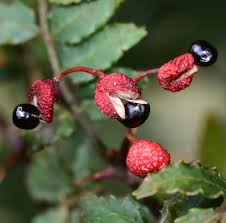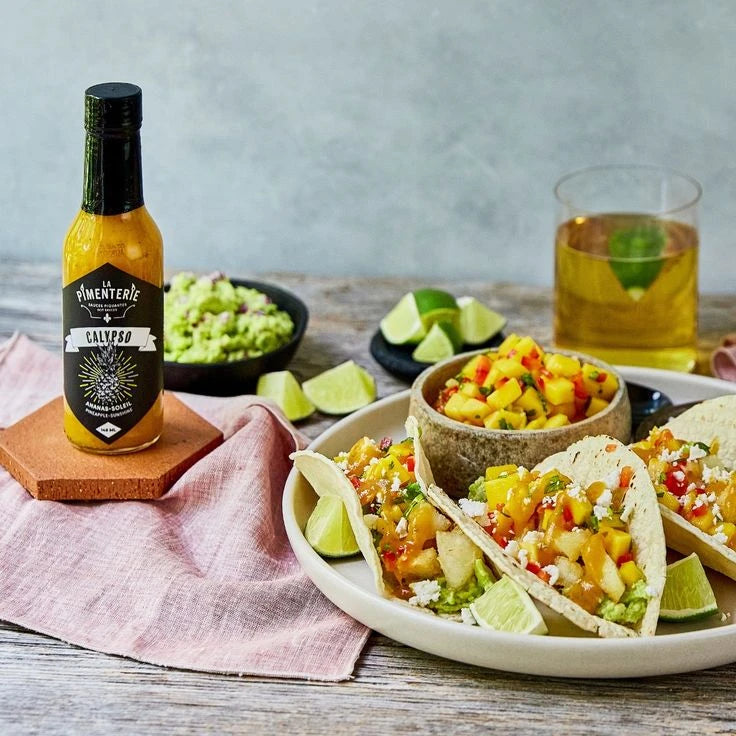Today, let's explore a Quebec treasure that sparks curiosity: the Northern Prickly-Ash. If you're the type who enjoys boreal spices and has an interest in creations that are out of the ordinary, you've come to the right place. At La Pimenterie, we love finding distinctive ingredients to awaken your taste buds, and that's precisely the role of the American pepper in our new electric sauce, one of two creations by the ANTIPODE duo. Get ready to rediscover spiciness, because this American pepper, with its notes of mandarin and grapefruit, offers a unique taste experience. Get ready, a unique sensation awaits you!
What is the Northern Prickly-Ash? The Northern Cousin with Unexpected Sensations
You're probably wondering what this marvel, the Northern Prickly-Ash, is all about. Let me tell you its story. It's much more than just a berry; it's a reflection of our terroir, an aromatic signature that leaves a lasting impression.
Zanthoxylum americanum : Much More Than Just Pepper
The Northern Prickly-Ash, scientifically known as Zanthoxylum americanum, is a rather thorny shrub that grows wild right here in Quebec. It belongs to the large Zanthoxylum family, making it the North American cousin of the famous Sichuan pepper, Japanese Sansho, and Nepalese Timut. Julien Clot of SymbiOse Alimenterre, who has been passionate about prickly ash for six years through a research project supported by the MRC des Laurentides (PFNL sector), confirms this: “American prickly ash is the North American cousin of the Zanthoxylum false peppers.”
But beware, our local prickly-ash has a strong character! “It has a distinctive flavor similar to tangerine-grapefruit and strong aromatic and analgesic properties,” Julien tells us. One of its unique features compared to its cousins is that, in the northern prickly-ash, “both males and females have aggressive thorns on their branches, which makes picking them quite difficult.” Pretty fascinating, isn't it? Julien has even seen plants change sex along the way! Unlike Sansho, where only the male is thorny, or Sichuan, which is more generous with its easy-to-pick clusters, our prickly-ash produces its berries in small, discreet groups at the division of the branches. It is a plant that has remained wild, little known to the first Europeans.
Key point : Northern prickly-ash (Zanthoxylum americanum) is a “false pepper” native to Quebec, a cousin of Sichuan pepper, with a unique citrus flavor (tangerine-grapefruit) and distinct growth characteristics. It is this uniqueness that gives ANTIPODE sauce its characteristic flavor.
A Wild Treasure of Quebec, from Montérégie to Outaouais
Our Northern Prickly-Ash is native to southern Quebec, particularly the Montérégie region, but it also thrives in the Ottawa Valley. For now, it is mainly harvested in the wild. “Its cultivation is very marginal,” explains Julien Clot. “We have started an orchard in the Mont-Tremblant region and a nursery through which we are beginning to sell rustic pepper plants.” An excellent initiative for the future of this boreal spice! Imagine being able to grow your own wild pepper from Quebec, resistant to cold and adapted to our temperate climate, it’s a beautiful promise.

The Sensory Secrets of the American Clavalier: The Special Effect of ANTIPODE
If the Northern Prickly-Ash appeals so much to La Pimenterie that it has become a key ingredient in its ANTIPODE “Électrique” sauce, it is thanks to its absolutely unique sensory profile. Prepare yourself for a range of sensations that go beyond the usual spiciness.
A Unique Aromatic Profile Combining Invigorating Citrus and a Tingling Sensation
Our Northern Prickly-Ash is native to southern Quebec, particularly the Montérégie region, but it also thrives in the Ottawa Valley. For now, it is mainly harvested in the wild. “Its cultivation is very marginal,” explains Julien Clot. “We have started an orchard in the Mont-Tremblant region and a nursery through which we are beginning to sell rustic pepper plants.” An excellent initiative for the future of this boreal spice! Imagine being able to grow your own wild pepper from Quebec, resistant to cold and adapted to our temperate climate, it’s a beautiful promise.
Julien Clot describes it with passion: “Prickly-Ash has a numbing effect, is a very powerful analgesic, slightly peppery-bitter, and has a citrus flavor all its own.” Imagine a lively freshness in the mouth, aromas of mandarin and clementine notes, a grapefruit scent, and a lingering lemony note. But that's not all. It causes that famous tingling sensation on the tongue, sometimes even a slight numbness in the mouth. It is this analgesic effect, accompanied by salivation (a bit like Sansho, but with a more pronounced anesthetic effect according to Julien), that contributes to the unique experience. Freshly picked, its fragrance is particularly captivating. Some also detect a subtle woody flavor and hints of eucalyptus. All this complexity makes it a sought-after spice in northern and wild cuisine, and an ingredient of choice for a distinctive sauce such as ANTIPODE's Electric, which combines the fruity spiciness of Aji Charapita chili peppers with this northern freshness.
Pro tip: To get to know the Northern Prickly-Ash, try just one berry. Let the flavors and sensations unfold. You'll be surprised by how the flavors evolve, from fruity to distinctive. It's this same distinctive quality that we sought to capture in ANTIPODE's Electric sauce!
Beyond Taste: Traditional Uses of the Toothache Tree
The Northern Prickly-Ash is not just a star in the kitchen. It is also a respected North American medicinal plant, nicknamed “toothache tree” by English speakers. Traditional indigenous remedies made use of its edible red fruits, bark, and leaves. Julien Clot tells us: “It was used for its analgesic, antiseptic, and antifungal properties, much like cloves, for oral and muscular problems.” The bark, fruit, and leaves were all valued. He also points out that the red osier dogwood can make the skin photosensitive, like certain citrus essential oils. Decoctions were also prepared to treat rheumatism. Its use in herbal medicine illustrates the richness of our local edible forest products.
Mastering the Art of the Northern Prickly-Ash: From the Forest to ANTIPODE
Now that you know almost everything there is to know about the Northern Prickly-Ash, you're curious to find out how it enriches ANTIPODE's Electric sauce and how you too can play with its flavors.
When and How to Harvest this Gem?
The harvest of Northern Prickly-Ash is in full swing in August. “You can pick them green for a lime flavor or red for a tangerine-grapefruit flavor,” explains Julien Clot. Its leaves are also aromatic, with citrus notes. The bark, meanwhile, is sought after in herbal medicine. Harvesting is an art that requires patience and respect. “Very few pickers harvest it, as places where it grows abundantly are very rare and picking it is difficult,” Julien points out. Everything is done by hand, sometimes with small tools, to make their way through these thorny deciduous shrubs.
The Challenges of Harvesting and Preservation: Valuable Expertise
The harvest of Northern Prickly-Ash fruit is in full swing in August. “You can pick it green for a lime flavor or red for a tangerine-grapefruit flavor,” explains Julien Clot. Its leaves are also aromatic, with citrus notes. The bark, meanwhile, is sought after in herbal medicine. Harvesting is an art that requires patience and respect. “Very few pickers harvest it, as places where it grows abundantly are very rare and picking it is difficult,” Julien points out. Everything is done by hand, sometimes with small tools, to make their way through these thorny deciduous shrubs.
Processing Northern Prickly-Ash is a real challenge, as Julien Clot explains: “It's the most difficult aspect of this spice. When ripe, the fruit is bursting with volatile, photosensitive essential oils.” The difference between pepper on the tree and after harvesting can be enormous, depending on how it is handled. At SymbiOse Alimenterre, they have tested several methods: hot drying, cold drying, salting, vinegar, alcohol, and freezing. “Each technique has its pros and cons,” says Julien. To best preserve the delicate aromas, freezing remains the best method, “but it must be used immediately after thawing.” A frozen clavalier can retain about 80% of its aromatic potential, compared to 20% to 40% for dried pepper. Gourmet Sauvage's clavalier pepper salt was born out of this research to make the spice more accessible.
Key point: Preserving American cloves is an art. When frozen, they are at their most flavorful but must be processed quickly. La Pimenterie takes great care to ensure the freshness of this ingredient in its Électrique sauce.
The Northern Prickly-Ash and Electric Sauce in Cooking
The culinary potential of Northern Prickly-Ash is “immense, just like their cousins in Asian cuisine,” explains Julien Clot. And when incorporated into a sauce such as ANTIPODE's Electric, the culinary possibilities expand. This sauce is versatile: it pairs well with fish and seafood thanks to its lemony freshness and unique texture. It adds an unexpected northern touch to poultry. A few drops are enough to spice up a fresh salad or add character to creamy sauces or reductions. prickly ash pepper marinades are a staple, but with ANTIPODE sauce, you'll discover a new dimension for infusing meat and fish. It can even surprise in desserts with red berries or pear, or add a zesty note to broths and soups. La Pimenterie also suggests it to add an original touch to cocktails! It is a true enhancer of Nordic dishes and the signature of a bold Nordic menu.
The Northern Prickly-Ash: From Forest to Plate, a Journey of Passionate People
Behind every Northern Prickly-Ash that goes into ANTIPODE's Electric sauce, there are passionate people, challenges, and a fierce determination to promote this Quebec product.
Gatherers and Producers: Meeting the Artisans of Taste
“We are the only ones we know of who are independent harvesters and producers in Quebec,” says Julien Clot of SymbiOse Alimenterre. “We know that Épices de Cru also sells the spice, and sources it from other harvesters.” Harvesting is a delicate art: you have to avoid the thorns and find generous sites to make the venture viable. “Despite the high price per kilogram, successfully harvesting enough, preserving it, packaging it, and offering the team a decent wage remains a central challenge,” explains Julien. It is this craftsmanship and respect for the product that La Pimenterie values.
The Promising Future of an Exceptional Spice
Northern Prickly-Ash is much more than just a passing fad. “We believe that this local spice has immense potential to be explored and much research to be done, both in terms of cultivation, harvesting, and packaging, as well as its flavors, therapeutic effects, and more,” concludes Julien Clot. Its use by gourmet chefs and its appeal as an original spice make it a sought-after product. It could also be used in herbal medicine, for massage oils, or oral hygiene products.
Pro tip: If you really want to grasp the essence of Clavalier d'Amérique, Julien Clot has one piece of advice: “You have to taste it! Powerful lemon-tangerine zest, a twist of citrus, etc.” And to make it easier to discover, La Pimenterie's Électrique ANTIPODE sauce is an excellent way to try it!
Ready to explore new sensations with ANTIPODE?
So, are you curious to discover the Northern Prickly-Ash and ANTIPODE Electric Sauce? This boreal spice has a lot to offer: an interesting history, a surprising aromatic profile, and culinary potential waiting to be explored. It's an invitation to explore the authentic flavors of our terroir, support local artisans, and inject a dose of originality and freshness into your dishes.











0 comments